Our Galakrond Warlock deck list guide goes through the ins-and-outs of this token-heavy Warlock build in Galakrond’s Awakening meta! This guide will teach you how to mulligan, pilot, and substitute cards for this archetype!
Introduction to Galakrond Warlock
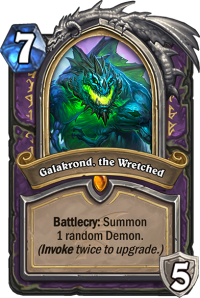
First things first – some people call the deck Galakrond Warlock, others call it Control Warlock, but it’s the same deck. We put both names in the title, but we always used “Galakrond Warlock”, so we’ll stick with this name.
Galakrond Warlock is a relatively new deck, although it plays a bit similarly to a bunch of slower Warlock decks we had in the past, just with a different win condition. The idea is to Life Tap quite a lot, get a big hand, then start coming back into the board with AoEs and dropping your own threats. However, unlike most of the popular Warlock builds we had in the past, Galakrond build goes wide instead of tall. It means that instead of dropping one or two big minions, it mostly floods the board with small and mid-sized minions. Both strategies have their upsides and downsides – token part is especially good against decks with no (or at least limited) AoE board clears.
Overall, it’s a solid Tier 2 deck and one of the best options available for Warlock right now.
Galakrond Warlock Deck List
Check out alternative versions of this deck on our Galakrond Warlock archetype page!
Galakrond Warlock Mulligan Strategy & Guide
VS Fast Decks
Higher Priority (Keep every time)
- Nether Breath – It’s one of your best cards against Aggro – for 2 mana you can remove most of the 1-3 mana minions (as well as some 4 mana minions) and heal for 4. Of course, you need a Dragon to activate it, but thanks to your Hero Power it shouldn’t be hard to find.
- Dark Skies – It’s an absolutely amazing board clear, you should be able to deal with most of the Aggro boards on curve, and surviving early game is the key to victory in those matchups.
- Dragonblight Cultist – Your best Invoke card – at the very least it’s a 3/1 that summons 2x 1/1 for 3 mana. Not bad at all, can make some good trades, and it brings you closer to activating both Worshipper and Galakrond himself.
Lower Priority (Keep only if certain conditions are met)
- Mortal Coil – Keep against decks that run early game 1 health minions for you to Coil – e.g. it’s good against Face Hunter, but not really good against Pirate Warrior.
- Devoted Maniac – Against decks that want to kill you quickly, you want to look for Nether Breath and Dark Skies, but either if you already have those or if you play against a slightly slower build, then Devoted Maniac is a good keep. You should be able to remove some small minion while leaving 2x 1/1 behind and – of course – Invoking Galakrond.
VS Slow Decks
Higher Priority (Keep every time)
- Dragonblight Cultist – Just like against Aggro, it’s your best Invoke card. Life Tapping on T3 is pretty awkward anyway, and the 3/1 is a solid threat that your opponent has to remove. It’s a good way to start the game.
- Devoted Maniac – While not as good as Cultist, it also produces three bodies and the reason you want to keep it is to get your Worshipper and Galakrond activated as soon as possible.
- Galakrond, the Wretched – It might seem weird, but Galakrond is actually a great keep in slow matchups. With how many cards you draw, having one dead in a slow matchup is not an issue. You will also often be able to play the fully upgraded version on Turn 7-8, and it’s just a huge swing in your favor when you do. All of those Invoke cards will flood the board, so there’s a chance that your opponent uses some of his AoE clears for those, and then he might not be able to deal with four random Demons.
Lower Priority (Keep only if certain conditions are met)
- Shield of Galakrond – Keep if you already have a solid curve. One of the ways to beat other slow-ish decks is to just curve out nicely and put pressure on them. They will have to focus on removing your stuff instead of going for their game plan and if you put enough pressure then they might use their cards non-optimally.
- Veiled Worshipper – If you have two Invoke cards already in your hand. 5/4 that draws 3 is just insane, but it’s obviously a bad keep if you will need to keep it until late game because you don’t have any Invoke cards.
Galakrond Warlock Play Strategy
Vs Aggro
Just like always against Aggro, your main goal is to survive. It’s even more important since you’re playing Warlock – Hero Powering costs you life, which is very beneficial to Aggro opponents. Luckily, Warlock got some solid anti-Aggro tools in Descent of Dragons, which is one of the main reasons why Galakrond Warlock is pretty good. Crazed Netherwing and Dark Skies have given this deck very solid board clears (while all of the token summoning made Plague of Flames playable). Then, Nether Breath is a great combination of single target removal and healing.
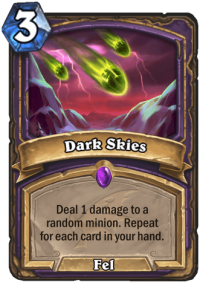
In faster matchups, the most important thing is to not fall behind. However, against decks that get onto the board very early it might be a bit difficult. You have almost no early game plays, most of the bodies you can drop on the board start on Turn 4, at which point it might be too late. That’s why it’s very important to get SOME Turn 3 play. Dark Skies is, in general, the best option, as you can set up your Turn 4 while usually clearing the entire board. If you skip Turn 1 (because you have nothing else to do) and Hero Power on Turn 2 (the same thing), it will be a 7 damage (going first) or 9 damage (when going second), and that’s mostly enough. Dragonblight Cultist is also a solid move – you summon a 3/1 and two 1/1’s, usually enough to clear at least 1 or 2 minions your opponent might have played. If he decides to trade down so you won’t get the best possible trades, while not a massive win, at least you won’t take damage. Play for the tempo and try to not Life Tap too much. You aren’t Handlock, so your cards (other than Dark Skies) aren’t getting stronger the more cards you hold. You want to play defensively, but play on the curve.
Since you have A LOT of ways to flood the board, your minions are disposable. Every AoE you play is double-sided, but don’t be afraid to use it even when you have board presence. As long as you will gain board advantage (because you can e.g. play another minion after clearing everything), then everything is fine.
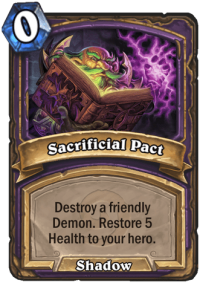
Your health total is very important. Keep in mind that against most of the fast decks you will struggle and barely keep yourself alive in many games. That balancing between life and death is very important – you need to understand how greedy you can get (e.g. with Life Taps) to not overextend. Knowing how much (more or less) damage your opponent can deal from the hand is beneficial. Try to stay a bit above that amount. As for your healing options, you have a few. The first one is actually Sacrificial Pact – the usual way you will use it is to kill of one of your 1/1 Demons summoned by Invoke cards. It’s pretty efficient, since you don’t have to sacrifice a lot and you gain 5 health for 0 mana. In the best case scenario you can clear something with it – save it for that if you face a deck that runs Demons, such as Zoo Warlock (or mirror matchup). Then, there’s Nether Breath – you obviously want to use it as a removal, but in the worst case scenario you can damage (or kill off) your own minion just to heal. Then there’s (obviously) Zilliax. Technically, Galakrond, the Wretched also “heals” for 5. If you’re desperate, you can play it even without upgrading it just for the +5 Armor. Not the most optimal play, but it’s better than surviving. And finally, a very important late game card – Alexstrasza. Most of the time, in Aggro builds you either use her on yourself on curve or keep in your hand “just in case”. Only when you’re in a really good position, you can drop it on the opponent.
At one point you have to turn the tides – in general, it’s hard to lose if you manage to stabilize at a solid health amount, but it’s still possible. Your opponent might have some ways to burn you down, so once you stabilize, you want to strike back quickly and possibly set up a 2-3 turns lethal. Dropping Galakrond is a good way if it’s fully upgraded – Aggro decks in general don’t run AoE board clears, so summoning four Demons (unless you absolutely low-roll it and summon four small bodies) should put enough stats on the board to really threaten your opponent (and then there’s 10 damage from your weapon).
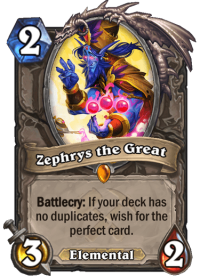
As for the Zephrys the Great and Dragonqueen Alexstrasza, those cards clearly aren’t made for fast matchups. Lots of the time they won’t even be active by the time the game is over. While it’s hard to talk about tempoing out a 9 mana 8/8, in case of Zephrys, it’s often more beneficial to just fit him into your curve as a 2 mana 3/2 than keep him in your hand until you draw all of your duplicates. Some extra tempo on the board will often help you much more. Deck tracker is very helpful – if you’re down to 1-2 duplicates in your deck, then you can consider keeping it. More than that – I would just toss him onto the board.
And last, but not least, there’s the matter of Kronx Dragonhoof. Against Aggro, you really, really prefer to play him AFTER already dropping Galakrond. Dealing 5 AoE damage or summoning an 8/8 Taunt are usually your best options depending on the matchup (dealing 5 damage and healing for 5 is not amazing, but also useful if you need health). However in practice, waiting until you draw Galakrond naturally, until you play it and then dropping Kronx is rarely possible. Of course, if you happen to draw Galakrond early, then you don’t want to drop a vanilla 6/6 (unless you have absolutely nothing better to do). But if you haven’t drawn Galakrond yet, Turn 6 Kronx might be a good play unless you’re behind and have to do something immediately. I’ve mentioned above that Galakrond himself is one of the best “turn around” cards, but only if he’s fully upgraded. That said, since you will spend lots of your turns catching up, you often won’t have time to play Kronx anyway.
Vs Control
While true “Control” matchups are not very popular in the current meta, this strategy section should be useful against any slower deck, not necessarily true Control builds. In general, while you have some Control tools yourself, in those matchups you usually want to take the aggressive role. The issue is that you have no real late game win condition. There’s no combo you run, you don’t have an infinite value generator (2x 1/1 from Hero Power gives you some more resources to work with, but it’s not that much), so you need to win the games as quickly as you can, through minion pressure.
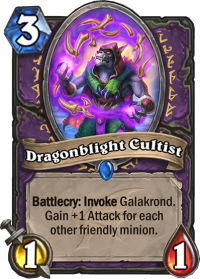
Against Control, you don’t need such a quick start, but ideally you still want to open with Dragonblight Cultist on Turn 3. It will start adding pressure to the board, especially if you follow it up with Fiendish Rites on Turn 4. In general, you want to keep your opponent busy. If you put pressure, you don’t let them develop and force them to AoE your board. Ideally, you want to force out those AoEs before you drop your Galakrond.
Given that slow decks don’t really threaten your life total, for the most part you don’t need to worry about your health. You can (and should) Life Tap a lot to not run out of resources in the mid/late game. You also don’t care about healing that much – Nether Breath can be saved for when you need the removal (or burn) and not healing, Sacrificial Pact is often useless (unless you face some Demons), but in certain cases 5 points of healing can be worth it.
Great thing about your AoEs is that some of them can be used as single target removals too. For example, Dark Skies – if your opponent clears the board and drops something, you can Dark Skies it and then start developing again. Playing some Invoke card + Plague of Flames, then developing further can also be a good way to turn the board around. You might consider saving Plague of Flames against Resurrect Priest or other deck that can flood the board with big minions, because it lets you answer those boards easily.
Kronx Dragonhoof can be game-winning in certain scenarios. A few different options are good depending on the situation. If you just need straight up burn – deal 5 damage. If you have an empty board and need to put some pressure – summon an 8/8. But probably the most useful one is +2/+2 to the rest of your board. If your opponent leaves a bunch of 1/1’s without clearing them, he risks a lot of burst damage from that. A seemingly harmless 5x 1/1 on the board can suddenly deal 15 damage and be much harder to remove. Those surprise lethals are often a good way to win the board.
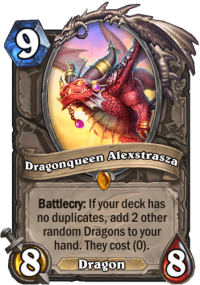
Your other late game win conditions include Zephrys the Great and Dragonqueen Alexstrasza. While those are often vanilla minions against faster decks, in slow matchups you have enough time to tap and draw with Veiled Worshipper (which is an MVP, by the way – but there’s no real strategy to it, just drop it after you Invoke twice and enjoy 5/4 body plus a bunch of cards). While there are certain scenarios in which you will have 2 copies of the same card on the bottom of your deck, in general they should be active around the time you have 5-8 cards left in your deck. Alexstrasza is just a massive tempo move – good thing is that by the time you drop her, your opponent should mostly be out of their AoEs, and dropping three Dragons on the same turn is big. Zephrys is more flexible and however you use it really depends on the situation. On the empty board, you might want to pick something like Tirion Fordring to have a big body that’s pretty hard to remove and then a solid weapon. Maybe you will need some removal – Zephrys will give it to you. Burn damage? Well, you can get either Fireball or Pyroblast (can’t use the latter immediately, but it’s still useful at times). And, of course, if you have a bunch of minions on the board already, you can grab Bloodlust and hopefully just finish the game. It’s an amazing card and you will often play it to close out the game.
And of course, Galakrond himself. Like I’ve said before, you want to bait a few AoEs first before dropping it. There are a lot of small Demons, but also a bunch of big ones, but on average they lean towards Midrange minions. That’s still enough – you will very often summon 10+ worth of Attack, so your opponent needs to answer those quickly or else he loses. If he already used his AoEs earlier, that’s great – he will have to work with single target removals, weapons, Rush minions and other ways to clear them. If he hasn’t – it’s still not the end of the world, because it’s another AoE bait. The thing is that at one point your opponent will no longer have a way to remove your stuff – maybe it will be after Galakrond, maybe after Alexstrasza, maybe after you flooded the board in the late game and then buffed it with Kronx/Zephrys etc.
You will usually draw through your deck much faster than your opponent, so going for fatigue strategy is not good. Same thing with “value” strategy – your deck is not packed with value and ways to generate more threats, so if your opponent managed to answer everything you played – you just lose. Sometimes it happens and you can’t really do anything about it.
Galakrond Warlock Card Substitutions
Most of the Galakrond Warlock builds are in the 10k-14k Dust range (counting the fact that Galakrond is free), which isn’t the worst, but they’re still among the more expensive decks in the meta. This particular build is on the expensive side. Then, there are still some cards you can cut, although lots of them are really necessary to play the deck. Here’s a full list of Epics & Legendaries with potential replacements (if applicable):
- Dark Skies – While it’s not really necessary, it does help your deck heavily. I honestly can’t imagine not running it, but I guess that you can try.
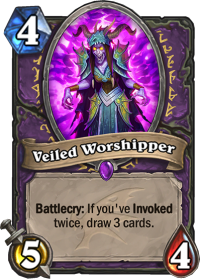
- Veiled Worshipper – You need Veiled Worshipper, it’s one of the main reasons to run Galakrond in the first place. It’s very easy to Invoke twice, and why wouldn’t you play a 4 mana 5/4 that draws 3 cards.
- Twisting Nether – It’s good to have another big AoE removal in some matchups, but it’s not necessary. You don’t really want to replace it with another AoE, you just want to run some tech card instead. That said, you probably need EITHER Nether or Godfrey – cutting both is too much.
- Zephrys the Great – Zephrys is basically an auto-include in the deck, because you draw so much and it gives you a really good late game win condition. But it’s not ABSOLUTELY necessary.
- SN1P-SN4P – It was given out for free, but it was a while ago. The card is solid, but not necessary.
- Zilliax – I’d guess that nearly everyone reading it has Zilliax already, since it’s been THE BEST Legendary to craft for over a year now, but if you’re still missing it, I think that it’s a bit too late to craft it (given that it rotates out in 2 months). The card is very useful, but not absolutely necessary.
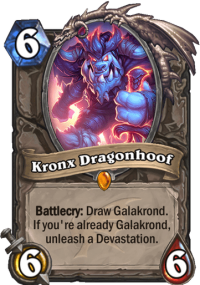
- Kronx Dragonhoof – Playing Galakrond deck without Kronx is, in general, a bad idea – this Legendary adds a lot of power with almost no downside. But if you don’t have it and absolutely want to play the deck, you can still try
- Lord Godfrey – Same as Twisting Nether.
- Alexstrasza – Regular Alex is also nearly a must-have in the deck. In faster matchups, it often saves you from death, while in the slower matchups it lets you turn the game around and set up a quick lethal. You can try to play the deck without it, but it will be significantly weaker. You will need another Dragon, though, because you won’t have enough to activate Nether Breath and Crazed Netherwing.
- Dragonqueen Alexstrasza – Like Zephrys, even though you don’t play a Highlander deck, you draw so much that it makes her useful. Not so much against Aggro, but she’s a great win condition vs slower decks. You can try replacing her, but both Alex and Zephrys are good crafts, since Highlander decks are here to stay for the next year. Same like regular Alex, you will need another Dragon if you want to replace her.
And here’s a bunch of cards you can use as replacements:
- Acidic Swamp Ooze – Tech card against weapons, while weapons are not VERY problematic in the current meta, it’s not a bad one to have.
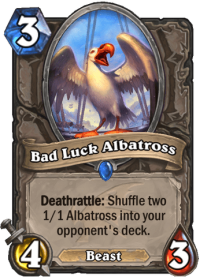
- Bad Luck Albatross – Albatross is actually a solid tech in the current meta – Highlander decks are pretty popular, and blocking them is always nice. Then, shuffling two 1/1’s into your opponent’s deck is good even against regular builds. And 4/3 for 3 is a decent stat-line.
- Fiendish Rites – After the nerf, this build only runs a single copy of Fiendish Rites, but if you’re missing some card, you can simply add a second copy instead.
- Hellfire – If you’re missing one of the AoEs, you can try out Hellfire, although it’s much worse than something like Dark Skies + it also damages you, so you will need to worry about your life total even more.
- Siphon Soul – It’s not the best single target removal ever, but Warlock doesn’t really have access to great “hard” removal, so it’s not a terrible substitute.
- Twilight Drake / Evasive Drakonid – If you replace some of your big Dragons, you need to replace them with other Dragons. Otherwise you won’t have ways to activate Nether Breath and Crazed Netherwing.
Leave a Reply
You must be logged in to post a comment.

updated guide soon for AoO? 😀
dragonblight cultist summons as a 3/1 on any empty board, little mistake there, but otherwise great guide keep it up!
Sorry, fixed it! I wanted to compare it to Microtech Controller but better, and then my brain somehow remembered that Cultist’s base stats are 2/1 and not 1/1 🙂
Bloodmage Thalnos is a great addition to combo with Dark Skies (2 Dmg per card in hand!) I’im using it in the place of SN1P-SN4P!
Do you know if it continues to be 2 damage if Thalnos dies out of interest?
Thalnos dies after the Dark Skies finishes to cast
That’s an interesting combo, I didn’t think about playing it with Spell Damage! I’ll definitely try it out 🙂